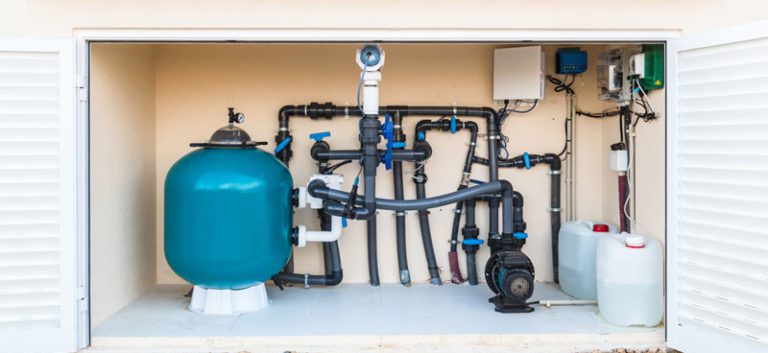Salt water chlorinators are one of the best investments a pool owner can make. They’re exceptionally cost-effective, easy to maintain, and environmentally friendly. Despite their high upfront cost, they’ll save you a lot of money in the long run.
With proper maintenance, the best salt water chlorinators can last well over five years. Luckily, cleaning your salt chlorinator takes no effort at all. In fact, you’ll only need to soak the chlorinator’s cell with an electrode cleaning solution for about 10-15 minutes three to four times a year. That’s it!
This article will guide you through everything you need to know about chlorinator maintenance, including how to clean salt water chlorinators and keep them in tip-top condition.
How Does A Salt Water Chlorinator Actually Work?
Salt water chlorinators work by converting salt water into chlorine gas, which cleans and sanitizes your pool. The conversion process happens in the chlorinator’s cells; salt water passes through the cell’s plates and is then converted to hypochlorous acid using electrolysis.
Since calcium is naturally attracted to the electrically charged plates, calcium build-up is expected. Mineral build-up decreases the efficiency of the machine’s chlorine production, which is why semi-regular maintenance is important.
Step-by-Step Guide On Cleaning Salt Water Chlorinators
As follows is a step-by-step salt water chlorinator cleaning guide that’s applicable with most salt chlorination systems:
Step 1: Get Your Cleaning Tools Ready
Before we start, you’ll first need to make sure you have everything you need at arm’s reach. Here are the items you’ll need:
- Salt water chlorinator cell cleaner
- Safety goggles, latex gloves, and mask
- Bucket
- Soft-bristled brush
- High-pressure garden hose (optional)
Chlorinator cell cleaners can be purchased in pool-cleaning supply stores or online. These cleaners usually come in already-prepared formulas, so you don’t have to worry about mixing anything yourself.
If you can’t find these chlorinator cell cleaners, you can instead use hydrochloric acid or muriatic acid. For every seven parts of water, add one part of muriatic acid.
The safety goggles, latex gloves, and mask are there to protect you from fumes or accidental splashes. You can also use coveralls if you have them.
The high-pressure garden hose makes mineral build-up removal a breeze, but it’s not a necessity. You can still clean the cells properly without it.
Step 2: Prepare Your Cleaning Solution
If you’re using a pre-mixed chlorinator cleaner, follow the recommended measurements given by the manufacturers. If you’re using hydrochloric acid, mix in one part hydrochloric or muriatic acid to seven parts water.
Always add the acid to the water and not the other way around to avoid accidental splashes.
Step 3: Unplug the Device and Remove Cell’s Plates
Turn off the machine’s power along with its filtration system. Close all the necessary valves, as well. Once done, unplug the terminal cap and carefully remove the salt chlorinator’s plates from its housing.
If you’re unsure about the removal process, we recommend checking and following the manufacturer’s instructions.
Step 4: Fill the Cell With the Prepared Solution
Most salt water chlorinator cells come with a cleaning stand that allows them to stand vertically. Attach said stand to the cell with the cord side down. The cell should stand upright.
Under the cell, place a dish or a small tub to catch any solution that may spill while cleaning the cell.
Fill the chlorinator cell with your solution of choice and let it stand for 10-15 minutes. During this process, you might notice the solution foaming up a bit. Don’t panic, this is normal! The foam is caused by the acid melting the mineral deposits stuck on the cell.
Step 5: Rinse the Solution With Clean Water
When 10-15 minutes is up, you can now rinse the chlorinator cell. Pour the solution into a bucket and place it a safe distance away. Be careful and make sure you’re wearing your protective gear.
Then, thoroughly rinse the inside of the chlorinator cell with clean water. You can use a high-pressure hose or a regular hose.
If loose calcium residue is still visible, use a soft-bristled brush to remove them. If it’s still hard, repeat the process above this one. When you’re done, the cell should be completely free of any kind of residue.
Step 6: Return the Cell
Once you’ve thoroughly cleaned the chlorinator cell, give everything a once-over to make sure it’s free of excessive tears and any other kind of damage.
Make sure its fittings are intact, too. If one part is broken or too old, replace it ASAP to prevent further damage down the line.
If your cell is completely damage-free, you can now attach it back into the system and turn the machine on.
Step 7: Properly Dispose of the Used Solution
Dispose of the used solution in accordance with your state’s rules for disposal. Pouring it down
the drain may damage your pipes because it’s corrosive, therefore making a safety hazard.
Some states allow you to simply dilute and flush the acid, while others may require you to neutralize the solution before dilution and disposal.
Some Salt Pool Chlorinator Cleaning and Maintenance Tips
Cleaning and maintaining your salt water chlorinator takes no time and effort at all. Here are some important tips to follow before, during, and after the cleaning process:
- Always wear protective gear when cleaning the chlorinator’s cells.
- If mineral deposits are still present in the cell even after two soaks, contact your pool specialist as it may require special attention.
- Don’t soak your chlorinator cell for longer than 10-15 minutes as the acid is highly corrosive and may damage the unit.
- Clean the chlorinator cell at least once per season (2-3 times a year) to prevent excessive calcium build-up.
- Monitor your pool’s salt level; it should always fall anywhere between 2,700 parts per million (ppm) and 3,400 ppm depending on the pool’s size.
The Bottom Line On How To Properly Clean Your Salt Water Chlorinator
When it comes down to it, salt water pool chlorinators don’t require much maintenance.
As long as you regularly check your pool’s salt water levels and clean the chlorinator’s cells at least twice a year, expect your machine to work as it should for many years to come. Happy swimming!
Also Check out the Video from American Pools and Spas’ Pool School for a in-depth video tutorial on how to clean your salt water chlorinator.

Hello, I am a writer and marketing specialist in Kansas City, MO. My love for swimming pools started as a child when I would visit my aunt & uncle’s inground swimming pool on a frequent basis over the summer. Since then I have taught swimming lessons at a Boy Scout Camp, participated in the full setup, installation and maintenance of my father’s inground swimming pool, as well as enjoyed constantly researching everything there is to know about swimming pools for 5+ years. I enjoy all water related sports, being part of the online swimming pool community and always learning new things!


Leave a Reply